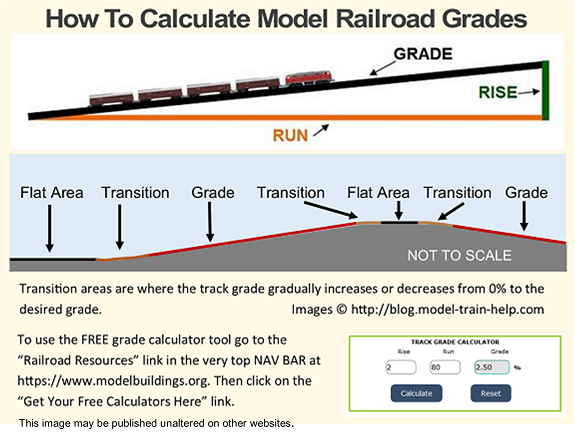Everything on model trains, model railroads, model railways, locomotives, model train layouts, scenery, wiring, DCC and more. Enjoy the world's best hobby... model railroading!
Calculating Grades – Graphic to share with friends
Model railroad grades are expressed as a percentage by dividing the rise over the run.
For example, a 3″ rise in 100″ run of model railroad track is 3% (3/100). Put another way, if you have 100 inches of track and your train climbs one inch, then your grade is 1 percent. When 25 inches of trackage rises 1 inch, your grade would be 4 percent. However, be aware your track will need to transition from the flat level to the gradient and back (see graphic). This will add to the run needed for your given gradient.
Real-world railroads might have three grade classifications: 0.8 percent to 1 percent which is considered ‘light grade’; 1 percent to 1.8 percent would be ‘heavy grade’; and anything steeper than 1.8 percent would be ‘mountain grade’ track. Real railroads operate for efficiency, whereas visual aesthetics are factors to consider on model railroads.
On a model railroad, grades can be used to enable more movements in a smaller space, and to make a train layout more visually appealing. Having a train pass on a track over another on a bridge can look particularly impressive. Even though grades on model train layouts are often steeper than on real railroads, grades greater than 2% can still pose problems. If you are using tight radius curves that can compound grades. Where possible, grades are best kept below 3%, however, some layout can and do accommodate steeper grades.
Grades on model railroads are generally steeper because, unlike on a real railroad where very long trains operate, there isn’t usually enough space to replicate a gradual gradient of several miles. However, the same principles need to be considered: the weight of your locomotive, the power of your locomotive, along with the weight and number of cars in your trains. A weak loco won’t be capable of pulling many cars up a grade. The steeper the grade is, the harder it will be. The greater the weight, the greater the traction… which means the wheels on your lighter locomotives could slip on grades that heavier locomotives can climb. Another thing to be aware of is that larger-scale locos will generally cope with steep grades better than smaller loco scales. As an example, a powerful N scale locomotive might pull around 14 to 16 cars up a 4 percent grade. Some train enthusiasts might think 14 to 16 cars is too short a train consist.
Feel free to share this graphic with friends, on Facebook, or on your website if you think it will be of help.
One Response to Calculating Grades – Graphic to share with friends
Leave a Reply





















Yes indeed – – – (1/50)*100 is 2 – – a 2 % grade.
For setting a long grade – –
Use 2 rulers set exactly 50 inches apart. The first uruller, observe any masurement point on it, say you pick the 2 inch mark.
The second ruler, observe the 3 inch mark ( 1 inch greater than the first ruler). Now set a tripod and a laser and connect the end points. You now have a 2% slope on the wall. Elevate your tripod or whatever up to where it needs to be to represent your subroadbed. Start construction!!